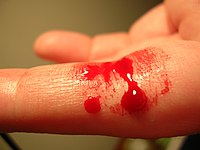
Photo from wikipedia
Objective To analyze the correlation between coagulation fibrinolysis function and outcomes during hospitalization in patients with severe traumatic hemorrhagic shock. Methods A retrospective collection was performed on the clinical data… Click to show full abstract
Objective To analyze the correlation between coagulation fibrinolysis function and outcomes during hospitalization in patients with severe traumatic hemorrhagic shock. Methods A retrospective collection was performed on the clinical data of 106 patients with severe traumatic shock admitted to the hospital between January 2020 and January 2022. According to the injury severity score (ISS), they were divided into the S1 group (ISS <25 points, n = 70) and the S2 group (ISS ≥25 points, n = 36). The prothrombin time (PT), fibrinogen (Fib), thrombin time (TT), and activated partial thromboplastin time (APTT) were detected by the coagulation assay. The aD-dimer (D-D) was detected by an enzyme-linked immunosorbent assay. Antithrombin activity (AT : A) and plasminogen activity (PLG : A) were detected by the chromogenic substrate method. The relationship between coagulation fibrinolysis indexes and injury severity was analyzed by Spearman's correlation analysis. The predictive value of coagulation fibrinolysis indexes for outcomes of patients with severe traumatic hemorrhagic shock was evaluated by receiver operating characteristic (ROC) curves. Results The levels of PT, APTT, D-D, TT, AT : A and PLG : A in the S2 group were higher than those in S1 group, while the Fib level was lower than that in the S1 group (P < 0.05). A Spearman's analysis showed that PT, APTT, TT, D-D, AT : A, and PLG : A were positively correlated with injury severity (P < 0.05), while Fib was negatively correlated with it (P < 0.05). Among the 106 patients, there were 89 survived cases and 17 died cases. The levels of PT, APTT, D-D, AT : A and PLG : A in the death group were lower than those in the survival group, while the Fib level was higher than that in the survival group. The results of ROC curve analysis showed that serum PT, APTT, Fib, TT and D-D were of predictive value for outcomes (AUC = 0.713, AUC = 0.683, AUC = 0.712, AUC = 0.761, AUC = 0.730, AUC = 0.765, AUC = 0.673, P < 0.05), and cutoff values were 20.29 s, 34.79 s, 3.54 g/L, 20.97 s, 1.42 μg/L, 73.53% and 63.97%, respectively. Conclusion There is coagulation and fibrinolysis dysfunction in patients with severe traumatic hemorrhagic shock, which is related to injury severity. The coagulation fibrinolysis indexes have a certain predictive value for outcomes of patients.
Journal Title: Emergency Medicine International
Year Published: 2022
Link to full text (if available)
Share on Social Media: Sign Up to like & get
recommendations!